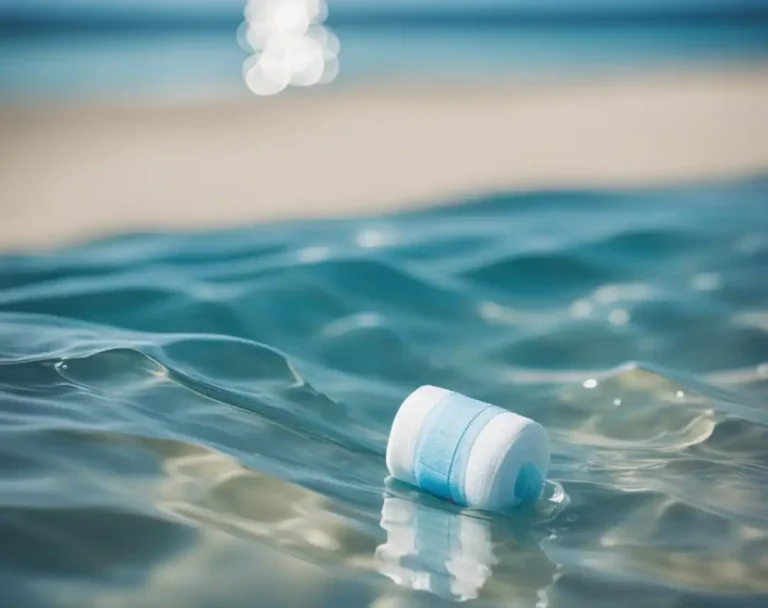Don’t let a scrape or cut keep you on dry land! “How to Waterproof a Wound for Swimming: 7 Safe Tips” is your essential guide to protecting minor injuries while you enjoy the water.
How to Waterproof a Wound for Swimming?
Types of Waterproof Dressings
Waterproof Bandages: These bandages provide a non-permeable barrier, allowing you to swim while drastically reducing the risk of water penetrating the dressing. They are flexible and often have a water-resistant adhesive.
- Hydrocolloid Dressings: Remarkably adherent, these dressings form a gel when in contact with the wound fluid, maintaining a moist environment that promotes healing.
- Foam Dressings: Ideal for wounds with higher levels of exudate. Their absorbent inner layer helps to draw fluid away, while a waterproof outer layer keeps moisture out.
Benefits of Keeping Wounds Dry and Clean
Prevents Infections: Submerging wounds in water without proper protection can introduce bacteria, hindering your recovery. By waterproofing your wound, you create a clean barrier against contaminants.
Promotes Healing: Dry conditions are preferable as they encourage faster wound healing. By using waterproof dressings, you ensure the ideal environment for your wound to heal, so you can resume your activities with confidence.
Preparing Your Wound for Swimming

Clean and Inspect the Wound
First things first, cleanliness is paramount! Start by gently washing the affected area with mild soap and water. This removes any debris or bacteria that could complicate healing.
After a thorough cleanse, carefully pat the wound dry with a clean towel or sterile gauze. Taking the time to inspect the wound is crucial; look out for signs of infection such as increased pain, redness, or swelling. If all looks well, you’re ready for the next phase of protection.
Securing the Waterproof Protection
After ensuring your wound is clean and dry, it’s time to securely waterproof your wound. Here’s how to do it:
- Apply an adhesive bandage: Choose a waterproof adhesive bandage that’s larger than the wound to cover it entirely.
- Seal the deal: Use waterproof tape to reinforce the edges of the bandage, ensuring the entire dressing stays intact.
Apply the tape in a crisscross pattern, maximizing the seal against water while keeping the skin comfortable. It’s a good idea to test the waterproof seal by applying light pressure around the edges. If any spots lift, reinforce them with additional tape. Remember, appropriate skin care is crucial, so apply a thin layer of petroleum jelly or antibiotic ointment before bandaging to maintain skin health and aid in preventing infection.
Aftercare and Precautions

Post-Swim Care
Immediately after you exit the water, gently rinse your wound with clean, fresh water, even if you were in a chlorinated pool or the sparkling ocean. The goal here is to remove any remnants of pool chemicals, salt, or bacteria that might have made their way past your waterproof barrier.
Carefully pat dry the area with a sterile towel and inspect the waterproof dressing to ensure it’s still intact. If the dressing is compromised, remove it, cleanse the wound, and apply a new protective layer.
- Rinse: Fresh water
- Dry: Pat with a sterile towel
- Inspect: Check waterproof dressing
Cautions and When to Avoid Swimming
Your enthusiasm for swimming should not eclipse the importance of wound care. Be mindful of the water conditions; high levels of bacteria in the ocean or a poorly maintained pool can increase your risk of infection. If you have a deep or fresh wound, avoid swimming altogether until your healthcare professional gives you the green light.
For signs of infection like redness, increased pain, or discharge, seek medical attention immediately. Moreover, to prevent ear infections, consider using earplugs, and always cover your wounds when swimming.
- Avoid: Poor water conditions, new or deep wounds
- Watch for: Signs of infection
- Use: Earplugs to prevent ear infection
- Seek: Healthcare professional’s advice
FAQ:
What is the best way to waterproof a wound?
The best way to waterproof a wound is by using a waterproof dressing or plaster and ensuring it’s sealed around the edges.
Do waterproof plasters work for swimming?
Yes, waterproof plasters are designed to protect wounds while swimming, keeping them dry and clean.
Can you swim in fresh water with an open wound?
Swimming in fresh water with an open wound is not recommended due to the risk of infection; cover it with a waterproof dressing if necessary.
How do you protect a wound from water while bathing?
Protect a wound from water while bathing by using a waterproof cover or plastic wrap sealed with waterproof tape.





